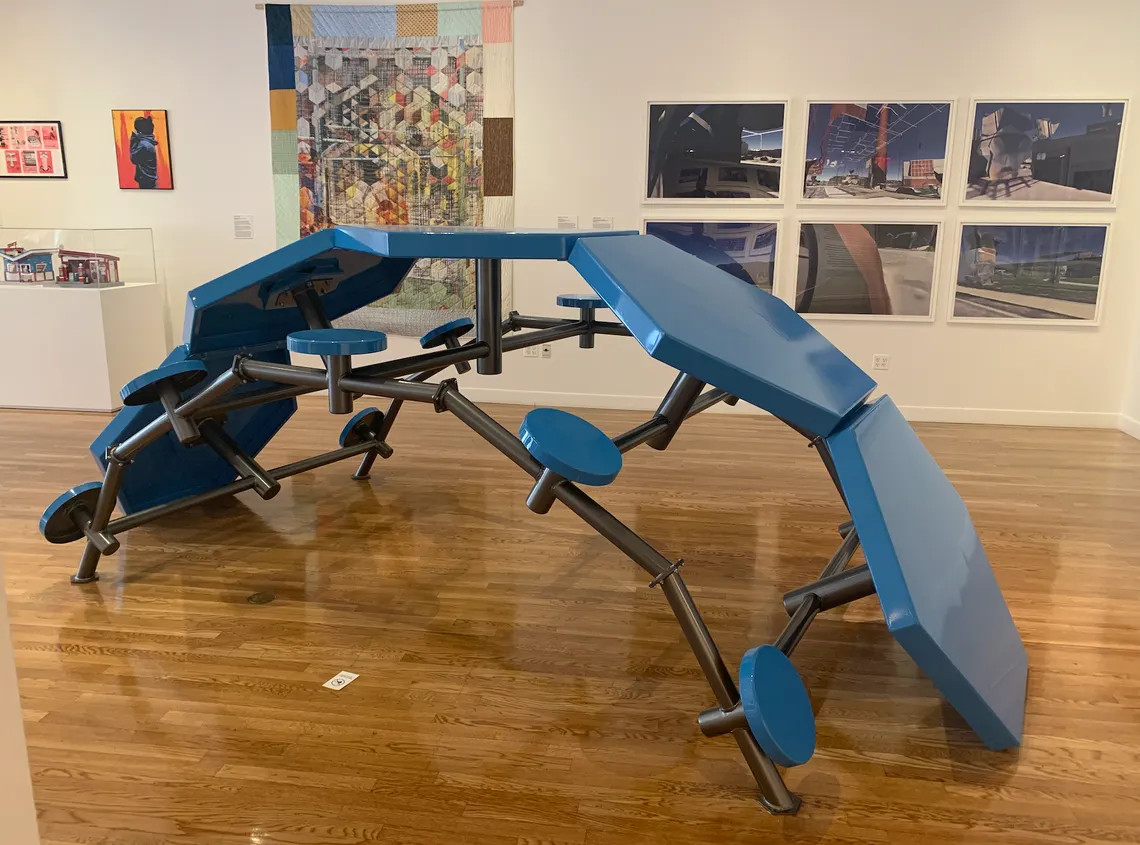This is The Marshall Project’s Closing Argument newsletter, a weekly deep dive into a key criminal justice issue. Want this delivered to your inbox? Subscribe to future newsletters here.
At first glance, the “Federal Prison Inmate Activity Book” looks like something a child might get at a fast food restaurant. But then you see that the word search puzzle includes terms like “larceny” and “embezzle.” On another page, above drawings of a panda and a one-eyed snake, it reads, “With so many gangs in prison, it’s hard to keep track! Circle the tattoos that might be found on gang members.”
The booklet wasn’t published by a prison; it’s a cheeky collaboration between artist Daniel McCarthy Clifford and an incarcerated person he kept anonymous “to protect them from retaliation,” according to a display card at the Schomburg Center for Research in Black Culture, in New York City. The center is currently showing “Marking Time: Art in the Age of Mass Incarceration,” an exhibit curated by New York University professor Nicole Fleetwood. It has toured several museums since 2020 and is one of at least four exhibits in New York this year that feature artists with prison experiences, along with similar shows in Arizona, California, Connecticut, Florida, Michigan, New Mexico and Wisconsin.
Together, they suggest a renaissance — not of prison art, which is probably as old as prisons, but of its public reception. Americans seem collectively more eager to engage with this work, and to understand the processes and experiences behind it. The visual counterpart to the music I covered in collaboration with The New York Times last week, prison art can convey the experiences of confinement, trauma and redemption, in ways that transcend words alone.

Much of the art in these new exhibits employs hard-earned virtuosity in the service of social commentary, from Mark Loughney’s drawings of his fellow prisoners to Jesse Krimes’ psychedelic quilts to Gilberto Rivera’s three-dimensional smears of paint and prison uniforms. But Clifford’s activity book stuck with me precisely because it isn’t a technical marvel. As with Marcel Duchamp’s famous urinal, your first reaction might be to laugh at its simplicity and irreverence. Clifford tried to send the booklets to federal prisons, but administrators rejected them as a security threat. So the object in the museum is imbued with the absurdities of censorship, especially when you consider that some prisons are letting in Hitler’s “Mein Kampf.”
With volume comes variety. For all the artists who show us prison’s horrors, others put playfulness and joy in the foreground. Native American artist Henry Frank constructed a bustling, miniature prison visitation room out of LEGO toys. After a childhood spent visiting her father in prison, sculptor Sable Elyse Smith used institutional stools and tables to assemble a structure that wouldn’t be out of place on a playground, showing how a child’s gaze can thwart the austerity of a visitation room, while also underscoring the effect of incarceration on loved ones on the outside. The Hollywood Reporter recently described Anthony Gomez’s mockumentary shorts as inspired by “The Office,” while NPR noted Sherrill Roland’s use of Kool-Aid in his sculptures.
Not all the artists make work that is directly about their physical circumstances, and some curators encourage them to go beyond “genres of traditional prison art.” “You have to actively seek new visual stimulation, or you’ll get stuck with the same old prison images, tears, bars, cement blocks, the very, very prison-like things,” Johnny Van Patten, a formerly incarcerated artist in Michigan, told Colossal earlier this year.
Still, most art signals the time spent making it. When you look at an eagle made of tiny folded magazine pages, or a miniature travel trailer made of teabags, cigarette foil and soda cans, it’s impossible not to think of these artists’ particular relationship to hours, weeks and years. “They are navigating endless penal time, scheduled by others, while mourning the loss of domestic time — family time, home time, free time,” Leslie Jamison wrote in The Atlantic when “Marking Time” debuted.
While museums are increasingly interested in showing this art (and there are more opportunities for collectors to buy it), many prisons still try to keep it inside. Several years ago, the Trump administration banned Guantánamo Bay prisoners from taking their art with them upon release. The Biden administration lifted the ban. Earlier this summer, New York state officials considered new restrictions on prison art, along with writing, music, and other creative work, which they scrapped after public outcry. But many states still try to bar artists from making money from their work, which can be a way to pay for the high cost of phone calls and commissary items.
Even when prison art reaches the public, there is no guarantee it will spark mercy. Earlier this summer, lawyers for Michael Tisius published his art as part of a campaign to stop his execution, arguing that he’d transformed himself on death row, since killing two jail guards in 2000.
The nature of prison art, like all art, is that its effects are impossible to predict and go far beyond the artist. Tisius was executed in June, but his murals still fill the walls of a Missouri prison. He wanted “to brighten [the] environment,” he said in his clemency application, and “erase some of the darkness of my past and to bring some beauty to this world, while I can.”